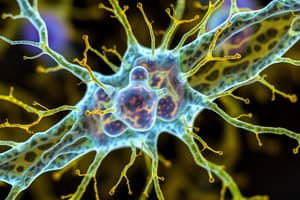Podcast
Questions and Answers
What is the primary function of microtubules in a cell?
What is the primary function of microtubules in a cell?
- To assist in the polymerization of actin filaments
- To provide mechanical strength
- To maintain cell shape by anchoring intracellular organelles
- To transport cargo and vesicles and form the mitotic spindle (correct)
Which of the following is NOT a feature shared by all cytoskeletal filament systems?
Which of the following is NOT a feature shared by all cytoskeletal filament systems?
- Ability to maintain cell shape
- Contribution to cell motility
- Interaction with accessory proteins
- Distinct mechanical properties and dynamics (correct)
What is the diameter of actin filaments (microfilaments)?
What is the diameter of actin filaments (microfilaments)?
- 15-20 nm
- 7-8 nm (correct)
- 10-12 nm
- 5-6 nm
What role do motor proteins play in the cytoskeleton?
What role do motor proteins play in the cytoskeleton?
Which type of protein polymerizes to form actin filaments?
Which type of protein polymerizes to form actin filaments?
What role does the cytoskeleton play in the structural integrity of a cell?
What role does the cytoskeleton play in the structural integrity of a cell?
Which of the following is NOT a function of the cytoskeleton?
Which of the following is NOT a function of the cytoskeleton?
What is the primary function of actin filaments?
What is the primary function of actin filaments?
Which filament is responsible for intracellular transport and positioning of organelles?
Which filament is responsible for intracellular transport and positioning of organelles?
How does the cytoskeleton contribute to cell division?
How does the cytoskeleton contribute to cell division?
Which of the following describes a characteristic of the cytoskeleton?
Which of the following describes a characteristic of the cytoskeleton?
What specialized structures can the cytoskeleton form?
What specialized structures can the cytoskeleton form?
What aspect of cell signaling is influenced by the cytoskeleton?
What aspect of cell signaling is influenced by the cytoskeleton?
Study Notes
The Cytoskeleton
- The cytoskeleton is a network of protein fibers that provides structure, support, motility, and regulation to cells.
- Key functions include: maintaining cell shape, providing mechanical strength, enabling cell movement, organizing cell components, and facilitating intracellular transport.
- The cytoskeleton is involved in various cellular processes such as endocytosis, cell division, and the formation of specialized structures like flagella and cilia.
Types of Cytoskeletal Filaments
- The cytoskeleton is composed of three major types of filaments: actin filaments, microtubules, and intermediate filaments.
- Each filament type has unique mechanical properties, dynamics, and biological roles.
- All three types of filaments work together to provide cells with strength, shape, and mobility.
Actin Filaments (Microfilaments)
- Actin filaments are helical polymers of the protein actin.
- They are thin and long fibers with a diameter of 7-8 nm.
- They contribute to cell surface shape and are essential for cell locomotion.
- They are also involved in cell division, specifically in the pinching process that separates one cell into two.
Microtubules
- Microtubules are hollow tubes composed of α- and β-tubulin protein dimers.
- They play a crucial role in organizing organelles within the cell.
- They also serve as tracks for motor proteins like kinesin and dynein, which transport cargo and vesicles throughout the cell.
- Microtubules form the mitotic spindle responsible for segregating chromosomes during cell division.
Intermediate Filaments
- Intermediate filaments are composed of various proteins and provide mechanical strength to cells.
- They are more stable than actin filaments and microtubules.
- They help maintain cell shape and resist tension.
- They also provide structural support to tissues and organs.
Accessory Proteins
- Accessory proteins play a crucial role in regulating the assembly and function of cytoskeletal filaments.
- They link filaments to other cell components, forming a complex and dynamic network.
- Motor proteins are among these accessory proteins, and they convert energy from ATP hydrolysis into mechanical force.
- This force is used to move organelles along filaments or to rearrange the filaments themselves.
Studying That Suits You
Use AI to generate personalized quizzes and flashcards to suit your learning preferences.
Related Documents
Description
Explore the intricate network of the cytoskeleton, its structure, and its vital functions within the cell. Learn about the different types of cytoskeletal filaments, including actin filaments, microtubules, and intermediate filaments, and their roles in cell shape, movement, and regulation.





